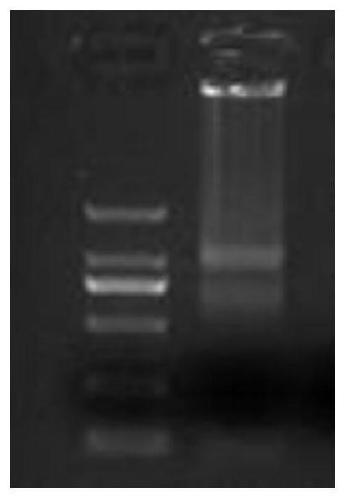Gene for improving cyst nematode resistance of soybeans and application of gene
A cyst nematode and gene technology, which is applied in the field of genes for improving soybean resistance to cyst nematode disease, can solve the problem that the number of cyst nematodes in the roots of susceptible soybean plants is large, the disease resistance operation is difficult, and the technical cost is high. problems, to achieve the effect of improving breeding efficiency, saving manpower and material resources, and reducing the number of females
- Summary
- Abstract
- Description
- Claims
- Application Information
AI Technical Summary
Problems solved by technology
Method used
Image
Examples
Embodiment 1
[0029] Example 1. Acquisition of genes that increase soybean resistance to cyst nematodes.
[0030] The nucleotide sequence of the gene for improving the resistance of soybean to cyst nematode described in this example is shown in SEQ ID NO:1. Obtained by cloning as follows.
[0031] 1) RNA extraction from the root of Dongnong L-10:
[0032] Extract RNA from the root tissue of Dongnong L-10 grown for 10 days, and extract by Trizol method:
[0033] (1) Add a little liquid nitrogen to the 1.5ml centrifuge tube containing the sample, and quickly and fully grind it to powder;
[0034] (2) Add 1 mL of Trizol extract to the tube, vortex for 30 s, oscillate to mix, and stand at room temperature for 5 min;
[0035] (3) Add 200 μL of chloroform to the tube, vibrate vigorously, vortex for 30 seconds, fully transform, and let stand at room temperature for 5 minutes;
[0036] (4) Centrifuge at 12000rpm for 15min at 4°C;
[0037] (5) Take the supernatant into a new 1.5 centrifuge tube...
Embodiment 2
[0060] Example 2. Application of GmRSCN16-1 in soybean breeding.
[0061] 1. Construct the plant overexpression vector pCSXN1250-GmRSCN16-1.
[0062] (1) Obtaining the full-length sequence of the resistance gene, the resistance gene GmRSCN16-1 was obtained through PCR amplification, product recovery and purification, ligation, transformation, identification and sequencing of positive clones, and the specific method was described in Example 1.
[0063] (2) Extraction of plasmid DNA
[0064] Use the E.Z.N.A. plasmid mini-prep kit to extract the plasmid.
[0065] (3) Linearization of the pCSXN1250 empty plasmid vector and gel recovery of the linearized plasmid.
[0066] The pCSXN1250 empty vector was digested with XcmΙ enzyme, 37°C for 1h. The digested products were subjected to 1% agarose gel electrophoresis, and the linearized plasmid vector DNA was recovered from the gel. This vector is an expression vector for TA cloning. The recombinant plasmid can be obtained by directl...
PUM
 Login to View More
Login to View More Abstract
Description
Claims
Application Information
 Login to View More
Login to View More - R&D
- Intellectual Property
- Life Sciences
- Materials
- Tech Scout
- Unparalleled Data Quality
- Higher Quality Content
- 60% Fewer Hallucinations
Browse by: Latest US Patents, China's latest patents, Technical Efficacy Thesaurus, Application Domain, Technology Topic, Popular Technical Reports.
© 2025 PatSnap. All rights reserved.Legal|Privacy policy|Modern Slavery Act Transparency Statement|Sitemap|About US| Contact US: help@patsnap.com



